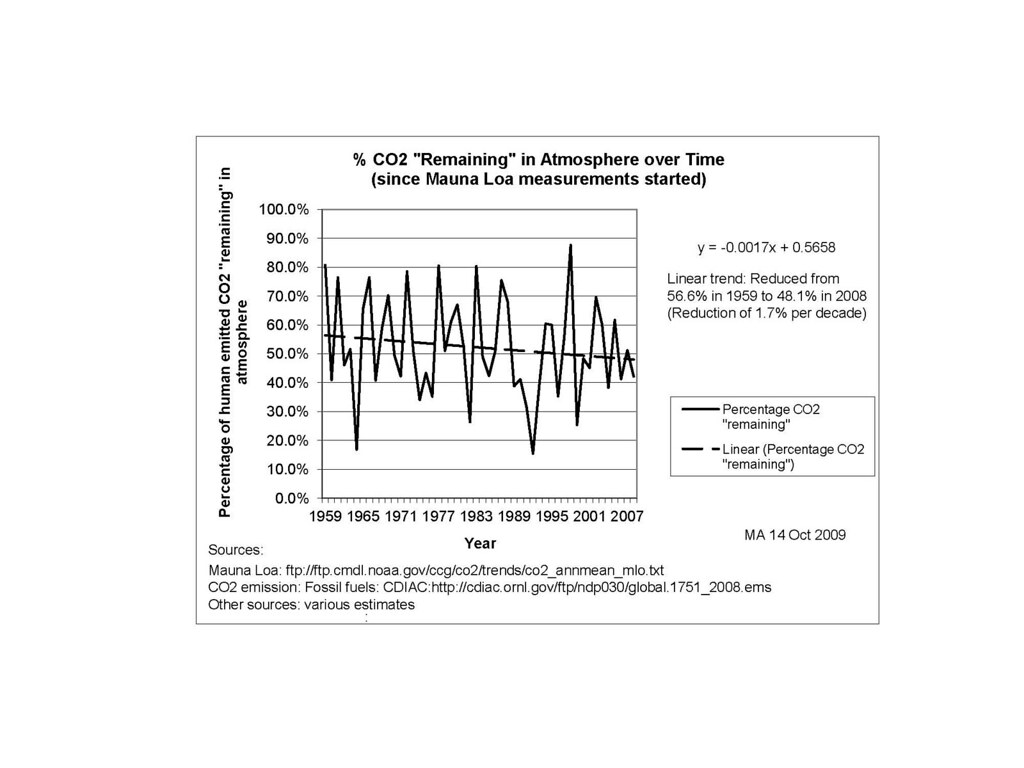As acknowledgement of the
atmospheric levels of CO2 reaching 400 PPM, this post is meant to clear up one important misconception (
suggested prerequisite reading on fat-tail CO2 sequestration here and the significance of the fat-tail here)
A recently active skeptic meme is that the amount of CO2 as an airborne fraction is decreasing over time.
"If we look at the data since Mauna Loa started, we see that the
percentage of the CO2 emitted by humans that “remains” in the atmosphere
has averaged around half, but that it has diminished over time, by
around 1% per decade.
Over the 30 year period 1959-1989 it was around 55%; over the following 20+ years it was just over 50%.
Why is this?"
What the befuddled fellow is talking about are the charts being shown below. These are being shown without much context and no supporting documentation, which puts the burden on the climate scientists to explain. Note that the airborne fraction does seem to decrease slightly over the past 50 years, even though the carbon emissions are increasing.

This obviously needs some explaining. The following figure illustrates what the CO2 sequestration model actually does.
 |
| Figure 1: Model airborne fraction of CO2 against actual data |
On the left is the data plotted together with the model of the yearly fraction not
sequestered out. The model is less noisy than the data but it does clearly decline as well. No big surprise as this is a response function, and responses are known to vary depending on the temporal profile of the input and the fat-tail in the adjustment time impulse response function.
On the right is the model with the incorporation
of a temperature-dependent outgassed fraction. In this case the model is more noisy than the data, as it includes outgassing of CO2 depending on the global temperature for that year. Since the temperature is noisy, the CO2 fraction picks up all of that noise. Still, the airborne fraction shows a small yet perceptible decline, and the model matches the data well, especially in recent years where the temperature fluctuations are reduced.
Amazing that over 50 years, the mean fraction has not varied much
from 55%. That has a lot to do with the math of diffusional physics.
Essentially a random walk moving into and out of sequestering sites is a
50/50 proposition. That’s the way to intuit the behavior, but the
math really does the heavy lifting in predicting the fraction sequestered out.
It looks like the theory matches the data once again. The skeptics provide a knee-jerk view that this behavior is not well understood, but not having done the analysis themselves, they lose out -- the skeptic meme is simply one of further propagating fear, uncertainty, and doubt (FUD) without concern for the underlying science.



On the right is the model with the incorporation of a temperature-dependent outgassed fraction. In this case the model is more noisy than the data, as it includes outgassing of CO2 depending on the global temperature for that year. Since the temperature is noisy, the CO2 fraction picks up all of that noise. Still, the airborne fraction shows a small yet perceptible decline, and the model matches the data well, especially in recent years where the temperature fluctuations are reduced.
Amazing that over 50 years, the mean fraction has not varied much from 55%. That has a lot to do with the math of diffusional physics. Essentially a random walk moving into and out of sequestering sites is a 50/50 proposition. That’s the way to intuit the behavior, but the math really does the heavy lifting in predicting the fraction sequestered out.
It looks like the theory matches the data once again. The skeptics provide a knee-jerk view that this behavior is not well understood, but not having done the analysis themselves, they lose out -- the skeptic meme is simply one of further propagating fear, uncertainty, and doubt (FUD) without concern for the underlying science.